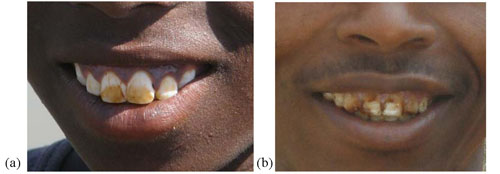6.2.3 Fluorosis
Fluoride is a substance found in nature that strengthens teeth and helps prevent tooth decay. Most water systems naturally contain some fluoride, but the amounts must be ‘just right’ to promote oral health. Not getting enough fluoride in the diet or water supply increases the risk of tooth decay. Many western countries either add it to tap water or advise people to use toothpastes containing fluoride. Communities in the highlands of Ethiopia have water supplies low in fluoride, so they are prone to faster rates of tooth decay than elsewhere.
However, very high concentrations of fluoride are even more damaging to the teeth. Water sources in the Ethiopian Rift Valley have very high fluoride levels, causing dental fluorosis (yellowish discoloration of the teeth, (Figure 6.6a) in their populations. A high intake of fluoride during childhood, especially in the first six to seven years of life, leads to severe fluorisis later in life (Figure 6.6b). This is associated with cracking and ‘pitting’ (tiny holes in the surface) of the teeth, which create cavities for bacteria to grow and cause tooth decay. The teeth become very weak and can easily break.

6.2.2 Tooth decay
